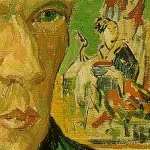

When you move up the walkway that leads to the visitor's wing at St. Paul's hospital, just outside St.-Rémy in Provence, the first structure you see is not the buiding that houses the recreated "Vincent's Room," the recreated bathing room, the gift shop, and the viewing room where a short film about Van Gogh's twelve month stay at St. Paul's is repeated interminably. What you see directly ahead of you is the wooden front door of a church. The hospital, after all, started as a Franciscan monastery. The monks, actually, were the first to take care of psychiatrically ill patients. And in Van Gogh's time an order of nuns helped out at the hospital. The church is small and quite dark, given that the only light is what sunlight manages to work through the small door and down the center aisle. It can get so dark that in order to really see the statues you have to illuminate them with the flash on your camera. In the wall behind and just bove the altar, three long stained glass windows are established featuring Saints Peter and Paul and Mother Mary. Like the hospital itself, the church is an enormously quiet location, one that lends itself to a certain urgent, reverent concentration. Even in the height of tourist season, not that many people wander in. Most push on to the other building to see Vincent's room; and the few who do enter speak in hushed tones if they speak at all.
Soon after first entering this church in 2005 I knew it needed a place in my novel. True confessions: I find no reference to it in the letters of Van Gogh, who had long since given up on organized religion by the time he admitted himself to St. Paul's. But when I saw the statue of Christ affixed to a wall at the front of the church (see photo) I had an idea for a scene. Namely, Vincent confronts this Jesus to whom he gave over his life, in all possible ways, for several years running, adhering so literally to the gospel of giving away all that you have--adhering to it even more literally than Jesus did--that he lost the confidence of the church administrators who had sent him to work in the Belgian mine country. Even after this period of religious frenzy passed, Van Gogh didn't abandon his respect for Jesus. But how, I thought, as I stood there in the dark, this statue before me, could he not--at least in some profoundly painful moments--feel eminently pissed off at the man; how could he not feel used by him? After all, Van Gogh sacrificed whole years of life, years he could have been working at art. Even then, I suspect, Van Gogh knew what was his true calling, and in part I think his persistence in wanting to serve Jesus as a lay preacher or a small town pastor or a missionary to miners (his notions evolved with changing circumstances and failures) was a way of denying the real vocation gnawing at him, because he knew the fierce commitment that the life of an artist would demand; he knew just how much it would take out of him before he could ever reach the level of expertise he would expect of himself. (And he was right.) That's my read on the situation. And if I'm right, how could he not be angry? Especially given how it all turned out; especially given where life had landed him? He would naturally be furious. Not just for those wasted years, not just for his eventual failure as "a man of the cloth," but that the very individuals who most frustrated him--confirmed holier-than-thou traditionalists who saw only one way to view other people and their actions, i.e., good or bad--the very people who scorned him, doubted him, gossiped about him, and dismissed him--were regarded in the eyes of the world as Good Christians whereas he, who had tried in the strictest sense to follow in the path of Jesus, was regarded as a lunatic. Why and how did Christ allow this to happen? What was the point? What was the benefit?
His pent up anger, resentment, and questioning surely would have come out if he ever found himself inside a house of worship, the kind of place he'd deliberately avoided for years. Getting him there was the tricky part. For what reason would he have come and with whom? The nuns who helped at St. Paul's likely had little interaction with the male patients, but I developed a reason why one nun asks permission to escort Van Gogh to the chapel, leaving him at the front (by that statue of Jesus) so that he can engage in private prayer while she waits for him in a rear pew. It's one of my favorite scenes in the entire novel, as I bounce back and forth between the separate perspectives of these two people, with Van Gogh's anger making connections to several different "eras" in his life and the novel: those already shown and some to be shown later. Not anything I intended when I first drafted the scene, but what seemed to magically occur on its own. And nothing I would have thought of if I hadn't stepped through the door in 2005.













0 comments:
Post a Comment